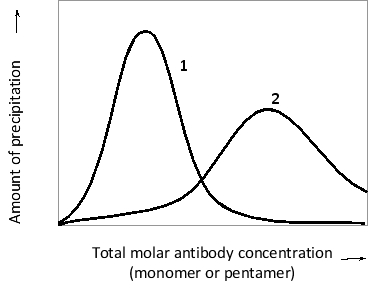Question 23
(Multiple Choice)
Antigens and antibodies can form large, insoluble, cross-linked aggregates that precipitate from solution. The maximal amount of precipitant is observed at a certain antigen/antibody ratio; adding either excess antigen or excess antibody can prevent (or even reverse) the precipitation. Consider an antigen with multiple identical antigenic determinants that can be recognized by either bivalent or decavalent (i.e. pentameric) antibodies with binding sites that recognize the determinants. The amount of precipitation in the presence of a constant antigen concentration is plotted as a function of antibody concentration in the following qualitative graph. Which curve (1 or 2) in the graph do you think corresponds to the bivalent antibody? Would you expect to see such a bell-shaped curve if the antibodies were monovalent? 
A) Curve 1; yes
B) Curve 2; yes
C) Curve 1; no
D) Curve 2; no
E) Curve 2; only if the antigen was also monovalent
Answer